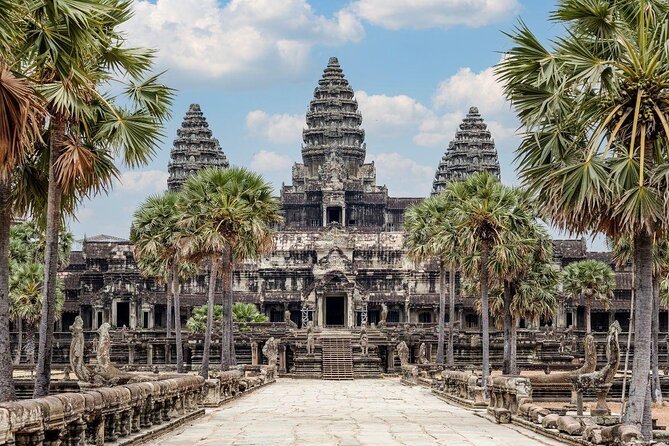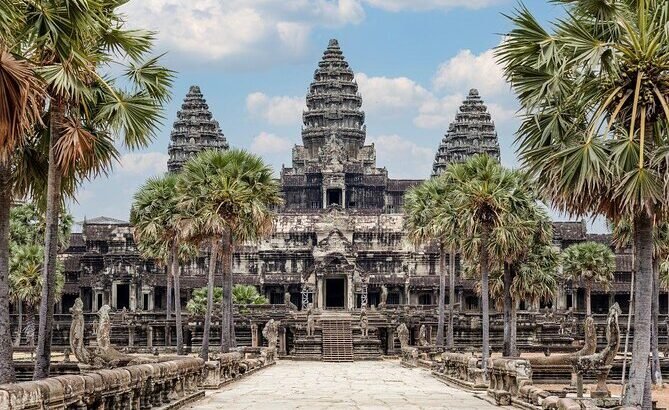
Tucked in the heart of Southeast Asia, rising majestically from the jungle near the town of Siem Reap, Angkor Wat stands as an architectural wonder, a spiritual beacon, and a symbol of Cambodia’s indomitable heritage. Known as the largest religious monument in the world, Angkor Wat is more than just a temple—it is a living canvas of Khmer civilization, a place where divine symmetry, intricate stone carvings, and celestial mythology merge into an unforgettable experience.
Built in the early 12th century, Angkor Wat was originally conceived as a Hindu temple dedicated to Vishnu but later transformed into a Buddhist sanctuary. Today, it continues to be both a national icon and an active place of worship. From sunrise to sunset, travelers from across the globe come to witness its grandeur, walk its sacred corridors, and feel the silent echo of centuries embedded in every carved wall and towering spire.
A Monument of Superlatives
Angkor Wat is a place of immense scale and precision. Covering more than 162 hectares, it dwarfs many of the world’s most renowned religious sites. The central temple complex alone consists of five towers, hundreds of galleries, and miles of bas-relief carvings that depict scenes from Hindu epics such as the Ramayana and Mahabharata.
It was constructed by King Suryavarman II in the early 1100s at the height of the Khmer Empire, a powerful civilization that ruled much of what is now Cambodia, Thailand, Laos, and southern Vietnam. The king envisioned Angkor Wat not only as a temple but as his mausoleum and a representation of Mount Meru—the sacred mountain in Hindu cosmology believed to be the center of the universe.
The result was a harmonious design that reflects spiritual symbolism: the towers represent the mountain’s peaks; the moat surrounding the complex mirrors the cosmic ocean; and the orientation and dimensions follow astronomical alignments. Every detail was calculated with divine purpose.
A Spiritual Journey Through Stone
To enter Angkor Wat is to cross a threshold between the earthly and the divine. The journey begins at the Western entrance, a causeway lined with stone balustrades shaped like nagas (mythical serpent deities). Unlike most Hindu temples which face east, Angkor Wat uniquely faces west—a direction often associated with death and the afterlife, hinting at its funerary function for King Suryavarman II.
As you walk the main causeway, the temple’s silhouette slowly reveals itself. The central sanctuary, rising to a height of 65 meters, is framed by four smaller towers in perfect symmetry. This arrangement not only dominates the skyline but serves to inspire reverence and awe in every visitor.
Inside, the atmosphere is hushed and contemplative. Monks in saffron robes light incense at shrines, and the air smells faintly of jasmine and sandalwood. Sacred corridors, their sandstone walls darkened by centuries of candle smoke and rain, open into sun-drenched courtyards and galleries filled with detailed bas-reliefs.
The Bas-Reliefs: Stories Carved in Time
One of Angkor Wat’s most captivating features is its continuous gallery of bas-reliefs stretching over 800 meters around the temple walls. These scenes are not merely decorative—they are profound narratives that merge religion, mythology, and royal propaganda.
Highlights include:
- The Churning of the Ocean of Milk: A cosmic tug-of-war between gods (Devas) and demons (Asuras) using the serpent Vasuki to churn the ocean, seeking the nectar of immortality. This masterpiece embodies harmony between opposing forces.
- The Battle of Kurukshetra: A vivid portrayal of the climactic war in the Mahabharata, symbolizing the eternal struggle between dharma (righteousness) and adharma (chaos).
- The Procession of King Suryavarman II: An idealized depiction of the king surrounded by his army, showing his divine status and political power.
Each figure, whether celestial dancer or fierce warrior, is rendered with incredible detail, demonstrating the artistic sophistication of Khmer sculptors. The carvings, still sharp after 900 years, speak volumes of their creators’ devotion.
From Hinduism to Buddhism: A Living Legacy
While Angkor Wat began as a Hindu temple, over time, Cambodia’s spiritual landscape evolved. By the 14th century, Theravada Buddhism had become the dominant religion, and the temple gradually transformed into a Buddhist sanctuary, a role it still plays today.
You’ll find Buddha statues draped in saffron cloths, and offerings of lotus flowers and incense placed with quiet reverence. The spiritual energy of the place is palpable—whether in a monk’s blessing, the serene smile of a visitor in prayer, or the soft chanting that sometimes drifts through the corridors.
This seamless fusion of religious traditions makes Angkor Wat a testament to spiritual continuity, rather than religious division. It reflects how Cambodians have historically embraced syncretism—the blending of faiths into a harmonious cultural identity.
Sunrise at Angkor: A Moment of Eternal Beauty
Perhaps no travel moment is more iconic than watching the sunrise over Angkor Wat. Before dawn, travelers gather by the north reflecting pool, the silhouette of the temple mirrored in still waters. As the sky shifts from inky blue to hues of gold, the towers gradually emerge—dark at first, then glowing in the morning light.
It is a moment that transcends photography. There is a hush, a sense of timelessness. For a few minutes, the world feels suspended in magic.
While sunrise draws the largest crowds, sunset offers quieter serenity, especially when viewed from Pre Rup or the outer walls, as golden rays touch the ancient stone.
The Greater Angkor Archaeological Park
While Angkor Wat is the crown jewel, it is part of a much larger complex known as the Angkor Archaeological Park, covering over 400 square kilometers and encompassing dozens of temples, reservoirs (barays), and canals.
Other must-visit sites include:
- Bayon Temple: Known for its enigmatic smiling stone faces, this temple in Angkor Thom reveals a different artistic and spiritual vision—more human, more Buddhist, and deeply intimate.
- Ta Prohm: Famously left in its semi-ruined state, this temple is a haunting fusion of stone and jungle. Massive roots of ancient trees coil around the towers and galleries, nature reclaiming human ambition.
- Banteay Srei: A smaller temple made of pink sandstone, known for its delicate carvings and intimate scale, often called the “Jewel of Khmer Art.”
Each site offers a different perspective on the empire’s history, aesthetics, and cosmology.
Cambodian Pride and National Identity
To the Cambodian people, Angkor Wat is more than a historical site—it is a symbol of national pride and identity. It appears on the Cambodian flag, the only national flag to feature a religious monument. It is also central to Khmer folklore, literature, and spiritual consciousness.
Surviving war, looting, and time, Angkor Wat stands resilient. Its continued preservation is a point of unity for Cambodians, representing hope and endurance. Efforts led by UNESCO, APSARA Authority, and international organizations have made significant strides in restoring damaged structures and protecting the site for future generations.
Preparing for Your Visit
To make the most of your Angkor experience, here are some essential tips:
- Buy an Angkor Pass: One-day, three-day, and seven-day passes are available. Most travelers opt for the three-day pass to explore the major temples at a relaxed pace.
- Hire a local guide: A knowledgeable guide can enrich your experience with stories, symbolism, and historical context you won’t find on plaques.
- Dress respectfully: As an active place of worship, modest attire (covered shoulders and knees) is required.
- Start early: Beat the heat and crowds by arriving at temples just after opening (5:30 AM).
- Hydration and sun protection: The tropical heat can be intense. Carry water, wear sunscreen, and bring a hat.
- Support local businesses: Buy souvenirs from responsible vendors, eat at community-run restaurants, and consider staying in eco-conscious accommodations.
Conclusion: A Place Where Time Stands Still
Angkor Wat is not just a destination—it is a pilgrimage of the heart and mind. In its corridors, stone galleries, and lotus-topped towers, you feel the pulse of an ancient empire. In the quiet of its sanctuaries, you hear whispers of monks, kings, and artists whose devotion shaped a masterpiece for the ages.
This sacred space invites you to slow down, to look deeper—not just into Cambodia’s history, but into your own sense of wonder. It is a place where stone speaks, shadows dance, and spirit and architecture become one.
To walk through Angkor Wat is to walk with history. To stand before its towers is to feel both humbled and uplifted. And to leave it behind is to carry a piece of its silent majesty with you—forever.




